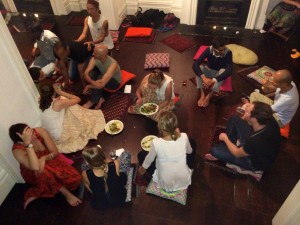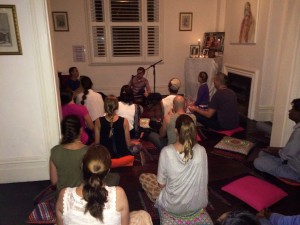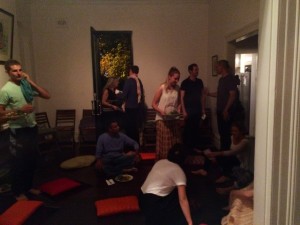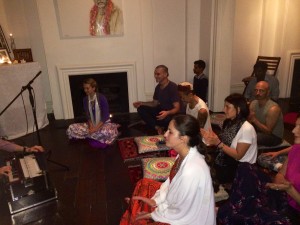
In the time honored traditions of ISKCON days gone by, Malati Prabhu was set on finding a suitable mate for Sriman Hamsaraj. As swans mate for life This new mate’s qualities must be just so; good breeding, young but experienced, attractive, loyal to a fault and above all a good swimmer.
So why, you may ask, is Srila Prabhupada’s dearest daughter, a respected leader with responsibilities that stretch from one side of the globe to the other, trying to hook up a lonely male resident of the Dhama? I’m glad you asked!
Sriman Hamsaraj is a swan. He’s been in New Vrindaban for many years now and was one of a group that graced the ponds below Sri-Sri Gaura Nitai. Unfortunately his friends left a number of years ago and his mate died so poor Hamsaraj has been holding a solitary vigil for the pleasure of Their Lordships and guests. The peacocks are always dancing around and crying to one another but none venture into the water. Occasionally an errant goose or mallard duck will drop in for a short visit but they are too soon on their way and Hamsaraj is once again alone.
It is the gentle heart that is most susceptible to the beautiful strains of Krsna’s flute and such a heart knows when someone needs a friend. This, then, was the motivation that put Malati Prabhu on a mission to find a partner for Hamsaraj.
The exotic animal auction in Ohio was coming up fast and the time was right. Ok, just a few typical New Vrindaban issues to take care of first…
Need a van to transport…got a van…battery’s dead…may need a new battery…get someone to charge the battery…got a charger…can’t find extension cords…got cords…need a key for the cabin to plug in the charger…got the key…outlet doesn’t work…find breaker box…turn on breaker…run cords…hook up charger…and wait…
Well, this is completely out of character for the Dhama! The battery actually took a charge, the van starts and now Malati’s back with a beautiful female swan she names Sri Devi. Sri Devi even has a red mark on her forehead like kum-kum. Ok Krsna, what’s up? I know something’s coming, it’s never THAT easy.
With the assistance of the always kind and helpful Murti, Malati introduces Sri Devi to her new home (and husband). But wait, I’m sure something is amiss, something just doesn’t feel right…buy swan…bring swan back…let swan out of van…swan goes into water and immediately joins her new mate…oh no…
In a move that would make Minnie Pearl proud, (Minnie who? never mind) Sri Devi was launched into her new life with her auction tag still securely attached to her leg. The calls start coming…Raghu tells of a previous swan this happened with that nearly lost her leg after only five days…the toes, however were not so lucky. Jaya Krsna Prabhu looks across the table and smiles, ”I’m SO happy you are taking care of this!” “I am?” “Yes, thank you VERY much!” I am…
The next several days are rainy and cold. The swans are swimming around in matrimonial bliss, oblivious to the machinations happening on shore.
“We need a net”.
“I have a net.”
“Where is it?”
“I don’t know…try my trailer under the mind numbing pile of clutter that I used to have organized before someone got in there and turned it upside down.”
“I looked, no net.”
A trip to Washington, PA for some flooring material yields the benefit of hitting Dick’s Sporting Goods for a net…of course there’s no one in that department to help. The nets are finally located and the biggest one is pulled off the rack. The holes in the netting are too big. Sri Devi would probably get her head caught in it and that would create a whole new bag off Dhama delights! Gander Mountain? Nope. Cabelas…ok, now we’re on to something. Holes are small enough, hoop is fairly large but the handle is kinda short. It’ll have to do. Seventy dollars?? Really? Plus tax. Oy vea! “You know the label is a little messed up…could you knock some off? “ The joke about needing a net to pick up a date seems to be working. A call to the manager and sixty dollars (plus tax) later and away we go.
So now what? Well let’s see…they’re eating some grain off the rocks by the steps… if I can just slowly sneak up on them, maybe get a little lucky… closer…. closer… almost there… just a few more feet…
“Hey, who’s the strange looking human with the funny thing in his hands?”
“I don’t think so!” “Time for a little swim to less congested waters.”
Ok, new plan…Use the kayak to chase the swans to shore, corral Sri Devi and distract Sriman Hamsaraj. Just so happens that male swans are VERY aggressive, especially when it comes to their mates. Far from running off, they’ll go after you like Gopisa on a gulab jamin.
Kalindi says that the swans like to steal the bread from the fish when she feeds them on Sunday. Ok Krsna, I’m beginning to see Your plan.
Paddles for the kayak? Check.
Half loaf of cheap white bread? Check.
Net? Check.
Scissors? Check.
Wire cutters? Check.
As I head out the door, Kalindi gives me a sympathetic look and says, “Good luck!”
It’s Saturday, 70 degrees, the sky is clear, winds light and everyone is fully engaged with a hundred and twenty something guests.
A stop by the Palace where Tejo and Gopal are fixing up the bathrooms to see how it’s going and solicit some help.
“Hey Tejo, wanna help catch the new swan?”
“Sure! Gopal, shut the door, no need to pack up. Hey, I’ll meet you down there.”
“Hey Gintras, wanna help catch a swan?”
“Sure, why not.”
A couple of Gosh’s workers are fixing up the area around the lodge for planting mint.
“Hey guys, can you help us catch a swan?”
“Yea, sure.” One looks over at the other, “You don’t swim do you?”
“Nope” “And I don’t want to get pecked to death either.”
Tejo: “Don’t worry, they have really small teeth.”
As Krsna would have it, both swans are on shore near the boat house. I throw some bread for them and they make their way farther on shore.
“Ok guys, move in behind them to keep ‘em from getting back into the water.”
“They’re starting to turn back, move fast!”
A well coordinated effort indeed! Hamsaraj took one look at Gopal and headed straight for the water. Sri Devi was corralled, netted and lay there passively while the band was clipped off. The band was not tight and the leg looks fine.
After she joined back up with her paramour, we heard a strange grunting sound. Not sure if that was Sri Devi saying thanks or Hamsaraj expressing his outrage over her treatment and offing a few choice comments of his own in a vain attempt to salvage some of his lost dignity.
 Three hour Harinam down Oxford and Carnaby streets and others. Delicious Prasadam, blissful association and a short nap in the fabulous Soho Temple Brahmacary ashram. If I don't make it in this life, that's where I want to come back to. There's definitely something very special about the UK and the devotees here. Your servant, Dharmatma das
Three hour Harinam down Oxford and Carnaby streets and others. Delicious Prasadam, blissful association and a short nap in the fabulous Soho Temple Brahmacary ashram. If I don't make it in this life, that's where I want to come back to. There's definitely something very special about the UK and the devotees here. Your servant, Dharmatma das 













 Vyasa Puja of H.H. Bhakti Vaibhava Swami
Vyasa Puja of H.H. Bhakti Vaibhava Swami 




